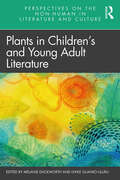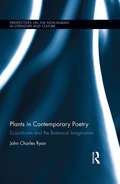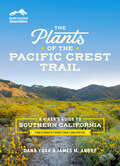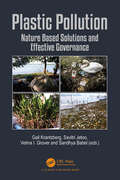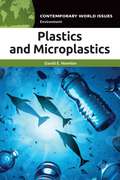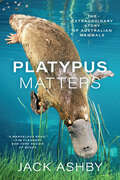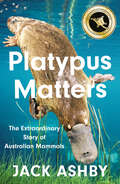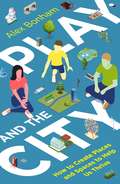- Table View
- List View
Plants in Children’s and Young Adult Literature (Perspectives on the Non-Human in Literature and Culture)
by Melanie Duckworth Lykke Guanio-UluruFrom the forests of the tales of the Brothers Grimm to Enid Blyton’s The Faraway Tree, from the flowers of Cicely May Barker’s fairies to the treehouse in Andy Griffith and Terry Denton’s popular 13-Storey Treehouse series, trees and other plants have been enduring features of stories for children and young adults. Plants act as gateways to other worlds, as liminal spaces, as markers of permanence and change, and as metonyms of childhood and adolescence. This anthology is the first compilation devoted entirely to analysis of the representation of plants in children’s and young adult literatures, reflecting the recent surge of interest in cultural plant studies within the environmental humanities. Mapping out and presenting an internationally inclusive view of plant representation in texts for children and young adults, the volume includes contributions examining European, American, Australian, and Asian literatures and contributes to the research fields of ecocriticism, critical plant studies, and the study of children’s and young adult literatures.
Plants in Contemporary Poetry: Ecocriticism and the Botanical Imagination (Perspectives on the Non-Human in Literature and Culture)
by John RyanPositioned within current ecocritical scholarship, this volume is the first book-length study of the representations of plants in contemporary American, English, and Australian poetry. Through readings of botanically-minded writers including Les Murray, Louise Glück, and Alice Oswald, it addresses the relationship between language and the subjectivity, agency, sentience, consciousness, and intelligence of vegetal life. Scientific, philosophical, and literary frameworks enable the author to develop an interdisciplinary approach to examining the role of plants in poetry. Drawing from recent plant science and contributing to the exciting new field of critical plant studies, the author develops a methodology he calls "botanical criticism" that aims to redress the lack of emphasis on plant life in studies of poetry. As a subset of ecocriticism, botanical criticism investigates how poets engage with plants literally and figuratively, materially and symbolically, in their works. Key themes covered in this volume include plants as invasives and weeds in human settings; as sources of physical and spiritual nourishment; as signifiers of region, home, and identity; as objects of aesthetics and objectivism; and, crucially, as beings with their own perspectives, voices, and modes of dialogue. Ryan demonstrates that poetic imagination is as essential as scientific rationality to elucidating and appreciating the mysteries of plant-being. This book will appeal to a multidisciplinary readership in the fields of ecocriticism, ecopoetry, environmental humanities, and ecocultural studies, and will be of interest to researchers in the emerging area of critical plant studies.
Plants in Contemporary Poetry: Ecocriticism and the Botanical Imagination (Perspectives on the Non-Human in Literature and Culture)
by John RyanPositioned within current ecocritical scholarship, this volume is the first book-length study of the representations of plants in contemporary American, English, and Australian poetry. Through readings of botanically-minded writers including Les Murray, Louise Glück, and Alice Oswald, it addresses the relationship between language and the subjectivity, agency, sentience, consciousness, and intelligence of vegetal life. Scientific, philosophical, and literary frameworks enable the author to develop an interdisciplinary approach to examining the role of plants in poetry. Drawing from recent plant science and contributing to the exciting new field of critical plant studies, the author develops a methodology he calls "botanical criticism" that aims to redress the lack of emphasis on plant life in studies of poetry. As a subset of ecocriticism, botanical criticism investigates how poets engage with plants literally and figuratively, materially and symbolically, in their works. Key themes covered in this volume include plants as invasives and weeds in human settings; as sources of physical and spiritual nourishment; as signifiers of region, home, and identity; as objects of aesthetics and objectivism; and, crucially, as beings with their own perspectives, voices, and modes of dialogue. Ryan demonstrates that poetic imagination is as essential as scientific rationality to elucidating and appreciating the mysteries of plant-being. This book will appeal to a multidisciplinary readership in the fields of ecocriticism, ecopoetry, environmental humanities, and ecocultural studies, and will be of interest to researchers in the emerging area of critical plant studies.
Plants of Desert Dunes (Adaptations of Desert Organisms)
by Avinoam DaninBased on three decades of field experience in southwest Asia, southern Africa, and the southwest United States, the author summarizes the major adaptations of plants to desert dunes. This integrative study of plant and diaspore morphology, reactive growth, life cycles, and environmental factors explains and predicts plant distribution. Many kinds of dune syndromes, plant case studies and vegetation transects are discussed and illustrated to clarify the significance of adaptations to specific habitat factors. Although the focus is on vascular plants, the development of microbiotic soil crust, its function, and its composition are discussed as well.
The Plants of the Appalachian Trail: A Hiker's Guide to 398 Species
by Dr. Kristen WickertIdentify an amazing range of plants along the Appalachian Trail with this guide to flowers, trees, and other vegetation you could experience on your next nature hike. Quickly find, identify, and learn about the amazing range of plants and fungi growing along the Appalachian Trail. It&’s easy with this guide, organized by type, color, and trail section. With hundreds of color photos and lively, accessible descriptions, there&’s so much you can learn. Keep an eye out for flame azaleas, violet coral fungi, pink lady slipper orchids, and oak trees that are hundreds of years old. Whether you&’re enjoying a day hike, exploring with your family, or setting out on the trek of a lifetime, you&’ll forge a deeper connection with nature through the beautiful plants on display mile after mile.
Plants of the Chesapeake Bay: A Guide to Wildflowers, Grasses, Aquatic Vegetation, Trees, Shrubs, and Other Flora
by Lytton John Musselman David A. KnepperButtonbush. Hercules' Club. Panic Grass. Tearthumb. Beach Spurge. Sea Rocket. Ladies' Tresses. These name a few of the wild and wonderful plants found in this quick reference guide to plants of the Chesapeake Bay. Written by wetland scientists with decades of experience in the Bay's waterways, this guide includes detailed descriptions and beautiful photographs of the plants most commonly found in the Chesapeake Bay. Grasses, trees, wildflowers, aquatic vegetation—if it grows in the tidal or nearshore regions of the Bay, chances are it is in this book, the features of which include• over 200 illustrations• information on more than 100 species of plants• clear, accessible descriptions of each plant accompanied by close-up photographs for quick, accurate identification• discussion of where to find each plant, how they reproduce, and how humans use them• easy-to-follow organization by habitatThe guide's vivid text and photographs make the wide array of plants along the waters, marshes, and shorelines of the Chesapeake Bay easy to identify and wondrous to behold. Its compact, portable design encourages naturalists, local residents, boaters, researchers, and the curious-minded alike to throw the guide in their pack and explore the botanical bounty of the Chesapeake Bay.
The Plants of the Pacific Crest Trail: A Hiker's Guide to Southern California
by Dana York James M. André.Identify the plants you&’ll see growing right next to you on the trail! Quickly find, identify, and learn about the amazing range of plants growing along the Southern California stretch of the Pacific Crest Trail. It&’s easy with The Plants of the Pacific Crest Trail, the first book of its kind, organized by type, color, and trail section. Over 1200 color photos and lively, accessible descriptions make your outing memorable. Did you know that you can see the world&’s biggest pinecone along the PCT? Or discover a plant that smells like cheese? Whether you&’re enjoying a day hike, exploring with your family, or setting out on the trek of a lifetime, you&’ll forge a deeper connection with nature through the beautiful plants on display mile after mile.
Plants of the World: An Illustrated Encyclopedia of Vascular Plants
by Maarten J. Christenhusz Michael F. Fay Mark W. ChasePlants of the World is the first book to systematically explore every vascular plant family on earth—more than four hundred and fifty of them—organized in a modern phylogenetic order. Detailed entries for each family include descriptions, distribution, evolutionary relationships, and fascinating information on economic uses of plants and etymology of their names. All entries are also copiously illustrated in full color with more than 2,500 stunning photographs. A collaboration among three celebrated botanists at the Royal Botanic Gardens, Kew, Plants of the World is authoritative, comprehensive, and beautiful. Covering everything from ferns to angiosperms, it will be an essential resource for practicing botanists, horticulturists, and nascent green thumbs alike.
Plants of the World: An Illustrated Encyclopedia of Vascular Plants
by Maarten J. Christenhusz Michael F. Fay Mark W. ChasePlants of the World is the first book to systematically explore every vascular plant family on earth—more than four hundred and fifty of them—organized in a modern phylogenetic order. Detailed entries for each family include descriptions, distribution, evolutionary relationships, and fascinating information on economic uses of plants and etymology of their names. All entries are also copiously illustrated in full color with more than 2,500 stunning photographs. A collaboration among three celebrated botanists at the Royal Botanic Gardens, Kew, Plants of the World is authoritative, comprehensive, and beautiful. Covering everything from ferns to angiosperms, it will be an essential resource for practicing botanists, horticulturists, and nascent green thumbs alike.
Plants with Style: A Plantsman's Choices for a Vibrant, 21st-Century Garden
by Kelly NorrisA fresh and exuberant guide to the best new ornamental plants handpicked by Kelly Norris, one of horticulture's brightest young stars.
Plastic and Microplastic in the Environment: Management and Health Risks
by Arif Ahamad Pardeep Singh Dhanesh TiwaryORGANIC REACTIONS Thought-provoking discussions of the challenges posed by—and potential solutions to—plastic and microplastic pollution In Plastic and Microplastic in the Environment: Management and Health Risks, a team of distinguished environmental researchers delivers an up-to-date exploration of plastic and microplastic environmental contamination, conventional and advanced plastics management techniques, and the policies adopted across the globe to combat the phenomenon of plastics contamination. Containing a balanced focus on both conventional plastics and microplastics, this book discusses the potential health issues related to plastic and microplastic infiltration in a variety of global environments and environmental media, including freshwater environments, oceanic environments, soil and sediment, and air. Insightful treatments of commercial and social issues, including the roles of corporate social responsibility initiatives and general education in the fight against plastic and microplastic pollution, are provided as well. Plastic and Microplastic in the Environment also includes: A thorough introduction to plastic debris in global environments, including its accumulation and disintegration Comprehensive explorations of policies for strengthening recyclable markets around the world Practical discussions of the prevalence of microplastics in the marine environment, air, soil, and other environmental media In-depth examinations of wastewater treatment plants as a potential source point of microplastics, as well as conventional and advanced microplastic particle removal technologies Perfect for academics, postgraduates and advanced undergraduates in fields related to environmental science and plastics, Plastic and Microplastic in the Environment: Management and Health Risks will also earn a place in the libraries of professionals working in the plastics industries and environmental policymakers.
Plastic and Microplastic in the Environment: Management and Health Risks
by Arif Ahamad Pardeep Singh Dhanesh TiwaryORGANIC REACTIONS Thought-provoking discussions of the challenges posed by—and potential solutions to—plastic and microplastic pollution In Plastic and Microplastic in the Environment: Management and Health Risks, a team of distinguished environmental researchers delivers an up-to-date exploration of plastic and microplastic environmental contamination, conventional and advanced plastics management techniques, and the policies adopted across the globe to combat the phenomenon of plastics contamination. Containing a balanced focus on both conventional plastics and microplastics, this book discusses the potential health issues related to plastic and microplastic infiltration in a variety of global environments and environmental media, including freshwater environments, oceanic environments, soil and sediment, and air. Insightful treatments of commercial and social issues, including the roles of corporate social responsibility initiatives and general education in the fight against plastic and microplastic pollution, are provided as well. Plastic and Microplastic in the Environment also includes: A thorough introduction to plastic debris in global environments, including its accumulation and disintegration Comprehensive explorations of policies for strengthening recyclable markets around the world Practical discussions of the prevalence of microplastics in the marine environment, air, soil, and other environmental media In-depth examinations of wastewater treatment plants as a potential source point of microplastics, as well as conventional and advanced microplastic particle removal technologies Perfect for academics, postgraduates and advanced undergraduates in fields related to environmental science and plastics, Plastic and Microplastic in the Environment: Management and Health Risks will also earn a place in the libraries of professionals working in the plastics industries and environmental policymakers.
Plastic Pollution: Nature Based Solutions and Effective Governance (Water)
by Gail Krantzberg Savitri Jetoo Velma I. Grover Sandhya BabelPlastics show up in every area of our lives. They are durable, cheap and light, properties that make them attractive but also problematic for the environment. The focus of this book is not just to highlight the problem of plastics, its definition, and how plastic pollution is impacting human health and environment but also to look at some best practices in both nature based solutions and in the field of law and policies. The first section of the book focuses on plastic pollution – it’s origin, relationship to climate change, linear/circular economy, followed by sustainable plastics, scientific solutions, and how policies can address plastic pollution. This includes looking at better designs, more sustainable feedstocks, and partnerships between various stakeholders worldwide including USA, China, Canada, South Korea, Thailand. This book will interest those who are associated with the production industry, packaging industry, and waste management industry as well as, academicians, students and policymakers.
Plastic Pollution: Nature Based Solutions and Effective Governance (Water)
Plastics show up in every area of our lives. They are durable, cheap and light, properties that make them attractive but also problematic for the environment. The focus of this book is not just to highlight the problem of plastics, its definition, and how plastic pollution is impacting human health and environment but also to look at some best practices in both nature based solutions and in the field of law and policies. The first section of the book focuses on plastic pollution – it’s origin, relationship to climate change, linear/circular economy, followed by sustainable plastics, scientific solutions, and how policies can address plastic pollution. This includes looking at better designs, more sustainable feedstocks, and partnerships between various stakeholders worldwide including USA, China, Canada, South Korea, Thailand. This book will interest those who are associated with the production industry, packaging industry, and waste management industry as well as, academicians, students and policymakers.
Plastic Sucks! You Can Make A Difference
by Dougie PoynterHow can YOU help save our planet? This awesome and inspiring guide, written by McFly bassist and environmental activist Dougie Poynter, will show you how to get involved in the mission to cut out single-use plastic.Plastic is everywhere and it sucks. It fills up our oceans, endangers our wildlife and never goes away. So it's time to take action, find ways to cut down our plastic use and help protect our environment. Together we can make a difference!As a lifelong supporter of environmental causes and a key player in the campaign to ban microbeads in the UK, Dougie is always on the hunt for ways to reduce and replace plastic. This campaigning book, his first solo authored project, draws on his own experiences in the fight against plastic waste – the problems he's encountered and the solutions he's found. It covers the history of plastic, introduces us to some key campaigners and eco entrepreneurs and is full of top tips and infographics. The clear and easy steps in Plastic Sucks! You Can Make a Difference show us how we can all make small changes and become champions for our planet.Includes contributions from:- Adam Lowry, founder of Method- Amanda Keetley, founder of Less Plastic UK- Anna Cummins and Marcus Eriksen, founders of 5 Gyres- Blue Ollis- Dara McAnulty- Edwin Broni-Mensah, founder of GiveMeTap- Emily Penn- James Robson and Andy Bool, Sea Life and Sea Life Trust- Jonathon Porritt- Josh White and Perry Fielding, co-founders of CanO Water- Kate Arnell- Lauren St John- Lucy Woodall- Will Travers, president of Born Free
Plastic Unlimited: How Corporations Are Fuelling the Ecological Crisis and What We Can Do About It
by Alice MahDespite the global movement to tackle plastic pollution, demand for plastics continues to rise. As the world transitions away from fossil fuels, plastics are set to be the biggest driver of oil demand. Single-use plastics – deemed essential in the fight against COVID-19 – have been given a new lease of life. In a world beset with crisis fatigue, what can we do to curb the escalating plastics crisis? In this book, Alice Mah reveals how petrochemical and plastics corporations have fought relentlessly to protect and expand plastics markets in the face of existential threats to business. From denying the toxic health effects of plastics to co-opting circular economy solutions to plastic waste and exploiting the opportunities offered up by the global pandemic, industry has deflected attention from the key problem: plastics production. The consequences of unfettered plastics growth are pernicious and highly unequal. We all have a part to play in reducing plastics consumption but we must tackle the problem at its root: the capitalist imperative for limitless growth.
Plastics and Microplastics: A Reference Handbook (Contemporary World Issues)
by David E. NewtonPlastic plays a vital role in today's world but has become increasingly problematic. Plastics and Microplastics: A Reference Handbook discusses the history and evolution of plastic and its many uses, both in the United States and around the world.Beginning with a history of plastic—from the first scientific discovery of the material to its diversity of forms and uses in the present day—Plastics and Microplastics: A Reference Handbook discusses the history and evolution of plastic and its many uses, both in the United States and around the world. Importantly, it delves into the problems and controversies concerning plastic and microplastics, such as the pollution of oceans, rivers, and streams; its exceptionally long shelf life; its contribution to air pollution; and ingestion of microplastics by marine life.One of the most valuable aspects of the book is its survey of the history of plastics and microplastics conducted in a manner that helps readers to identify key issues to address. Moreover, it discusses both implemented and proposed solutions. A perspectives chapter includes a broad range of voices, allowing crucial, diverse perspectives to round out the author's expertise.
Plastics and Microplastics: A Reference Handbook (Contemporary World Issues)
by David E. NewtonPlastic plays a vital role in today's world but has become increasingly problematic. Plastics and Microplastics: A Reference Handbook discusses the history and evolution of plastic and its many uses, both in the United States and around the world.Beginning with a history of plastic—from the first scientific discovery of the material to its diversity of forms and uses in the present day—Plastics and Microplastics: A Reference Handbook discusses the history and evolution of plastic and its many uses, both in the United States and around the world. Importantly, it delves into the problems and controversies concerning plastic and microplastics, such as the pollution of oceans, rivers, and streams; its exceptionally long shelf life; its contribution to air pollution; and ingestion of microplastics by marine life.One of the most valuable aspects of the book is its survey of the history of plastics and microplastics conducted in a manner that helps readers to identify key issues to address. Moreover, it discusses both implemented and proposed solutions. A perspectives chapter includes a broad range of voices, allowing crucial, diverse perspectives to round out the author's expertise.
Plasticus Maritimus: An Invasive Species (pdf) (David Suzuki Institute Ser.)
by Ana Pego Isabel Minhós Martins Bernado P. Carvalho"Clever…beguiling….Readers age 11 and older are likely to finish this book feeling both persuaded and uplifted. Beauty has a way of doing that." -Wall Street Journal For young readers comes an imaginative guide to ocean plastics, filled with tips and tricks for identifying—and combating—pollution in our oceans. Inspired by biologist AnaPêgo's life’s work, and filled with engaging science and colorful photographs, this foundational look at plastic pollution in the ocean explains why it is such an urgent contemporary issue. When she was young, Ana Pêgo didn’t play in a backyard, but on a beach. She walked along the shore, looked at tide pools, and collected fossils. As she grew older, Pêgo noticed a new species at the seaside: plastic. She decided to collect it, study it, and give it a Latin name—Plasticus maritimus—to warn people of its dangers to our planet. Pêgo tells us how plastics end up in our rivers, lakes, and oceans, shares plastic’s chemical composition and physical properties, and offers a field guide to help readers identify and understand this new invasive species in all its forms, from the obvious (fishing nets and water bottles) to the unfamiliar (tiny, clear particles called microplastics). Finally, she offers a critical look at our current “solutions” to plastic contamination and in her most important proposal—REVOLUTIONIZE—calls for deep changes in our habits, motivating young and old alike to make a difference, together. An artificial and almost indestructible species, Plasticus maritimus deserves to have its days numbered! Together, we can send it packing. “A cleverly conceived and comprehensive introduction to a serious issue.”—Kirkus Reviews Honorable Mention—Bologna Ragazzi Award Published in Partnership with the David Suzuki Institute.
Platypus Matters: The Extraordinary Story of Australian Mammals
by Jack AshbyScientifically informed and funny, a firsthand account of Australia’s wonderfully unique mammals—and how our perceptions impact their future. Think of a platypus: They lay eggs (that hatch into so-called platypups), produce milk without nipples and venom without fangs, and can detect electricity. Or a wombat: Their teeth never stop growing, they poop cubes, and they defend themselves with reinforced rears. And what about antechinuses—tiny marsupial carnivores whose males don’t see their first birthday, as their frenzied sex lives take so much energy that their immune systems fail? Platypuses, possums, wombats, echidnas, devils, kangaroos, quolls, dibblers, dunnarts, kowaris: Australia has some truly astonishing mammals, with incredible, unfamiliar features. But how does the world regard these creatures? And what does that mean for their conservation? In Platypus Matters, naturalist Jack Ashby shares his love for these often-misunderstood animals. Informed by his own experiences meeting living marsupials and egg-laying mammals during fieldwork in Tasmania and mainland Australia, as well as his work with thousands of zoological specimens collected for museums over the last two-hundred-plus years, Ashby’s tale not only explains historical mysteries and debunks myths (especially about the platypus), but also reveals the toll these myths can take. Ashby makes clear that calling these animals “weird” or “primitive”—or incorrectly implying that Australia is an “evolutionary backwater,” a perception that can be traced back to the country’s colonial history—has undermined conservation: Australia now has the worst mammal extinction rate of any place on Earth. Important, timely, and written with humor and wisdom by a scientist and self-described platypus nerd, this celebration of Australian wildlife will open eyes and change minds about how we contemplate and interact with the natural world—everywhere.
Platypus Matters: The Extraordinary Story of Australian Mammals
by Jack AshbyScientifically informed and funny, a firsthand account of Australia’s wonderfully unique mammals—and how our perceptions impact their future. Think of a platypus: They lay eggs (that hatch into so-called platypups), produce milk without nipples and venom without fangs, and can detect electricity. Or a wombat: Their teeth never stop growing, they poop cubes, and they defend themselves with reinforced rears. And what about antechinuses—tiny marsupial carnivores whose males don’t see their first birthday, as their frenzied sex lives take so much energy that their immune systems fail? Platypuses, possums, wombats, echidnas, devils, kangaroos, quolls, dibblers, dunnarts, kowaris: Australia has some truly astonishing mammals, with incredible, unfamiliar features. But how does the world regard these creatures? And what does that mean for their conservation? In Platypus Matters, naturalist Jack Ashby shares his love for these often-misunderstood animals. Informed by his own experiences meeting living marsupials and egg-laying mammals during fieldwork in Tasmania and mainland Australia, as well as his work with thousands of zoological specimens collected for museums over the last two-hundred-plus years, Ashby’s tale not only explains historical mysteries and debunks myths (especially about the platypus), but also reveals the toll these myths can take. Ashby makes clear that calling these animals “weird” or “primitive”—or incorrectly implying that Australia is an “evolutionary backwater,” a perception that can be traced back to the country’s colonial history—has undermined conservation: Australia now has the worst mammal extinction rate of any place on Earth. Important, timely, and written with humor and wisdom by a scientist and self-described platypus nerd, this celebration of Australian wildlife will open eyes and change minds about how we contemplate and interact with the natural world—everywhere.
Platypus Matters: The Extraordinary Story Of Australian Mammals
by Jack AshbyA compelling, funny, first-hand account of Australia's wonderfully unique mammals and how our perceptions impact their future.
Platypus Matters: The Extraordinary Story of Australian Mammals
by Jack AshbyScientifically informed and funny, a firsthand account of Australia’s wonderfully unique mammals—and how our perceptions impact their future. Think of a platypus: They lay eggs (that hatch into so-called platypups), produce milk without nipples and venom without fangs, and can detect electricity. Or a wombat: Their teeth never stop growing, they poop cubes, and they defend themselves with reinforced rears. And what about antechinuses—tiny marsupial carnivores whose males don’t see their first birthday, as their frenzied sex lives take so much energy that their immune systems fail? Platypuses, possums, wombats, echidnas, devils, kangaroos, quolls, dibblers, dunnarts, kowaris: Australia has some truly astonishing mammals, with incredible, unfamiliar features. But how does the world regard these creatures? And what does that mean for their conservation? In Platypus Matters, naturalist Jack Ashby shares his love for these often-misunderstood animals. Informed by his own experiences meeting living marsupials and egg-laying mammals during fieldwork in Tasmania and mainland Australia, as well as his work with thousands of zoological specimens collected for museums over the last two-hundred-plus years, Ashby’s tale not only explains historical mysteries and debunks myths (especially about the platypus), but also reveals the toll these myths can take. Ashby makes clear that calling these animals “weird” or “primitive”—or incorrectly implying that Australia is an “evolutionary backwater,” a perception that can be traced back to the country’s colonial history—has undermined conservation: Australia now has the worst mammal extinction rate of any place on Earth. Important, timely, and written with humor and wisdom by a scientist and self-described platypus nerd, this celebration of Australian wildlife will open eyes and change minds about how we contemplate and interact with the natural world—everywhere.
Play and the City: How to Create Places and Spaces To Help Us Thrive
by Alex BonhamPlay is essential, for children but also adults. It's how we relax and revitalise ourselves, build and maintain friendships, try new things, learn and innovate.Cities have always been sites of play, bringing people together and pushing the boundaries of what is humanly possible. And now we need our cities to encourage and facilitate play of all kinds more than ever. If we want a world for our children to play in, we need to have a go at doing things differently. A city that is enjoyable to live in - that provides welcoming spaces, plentiful resources, and an attitude of 'yes, you can' - is a playful city. A city that is good for eight-year-olds as well as eighty-year-olds is a city that's good for all of us. By looking at how different cities across space and time have sought to encourage and facilitate play, Bonham shows us how to conceptualise our own contemporary city as a game, and encourages us to become participants rather than spectators.Play the city! Get involved, make a difference and help to bring your city back to life. There is help here to identify opportunities, build a team of friends and allies, take part - and win! It's time to make your move.
